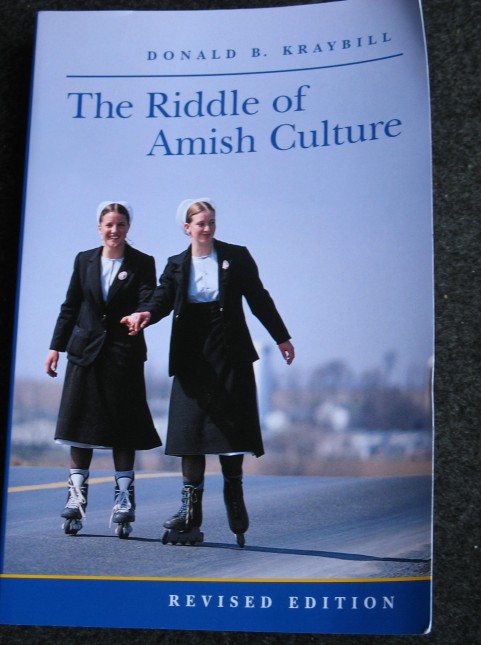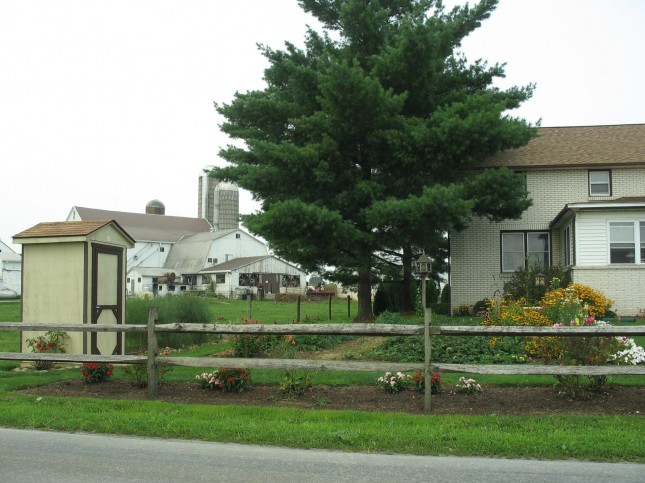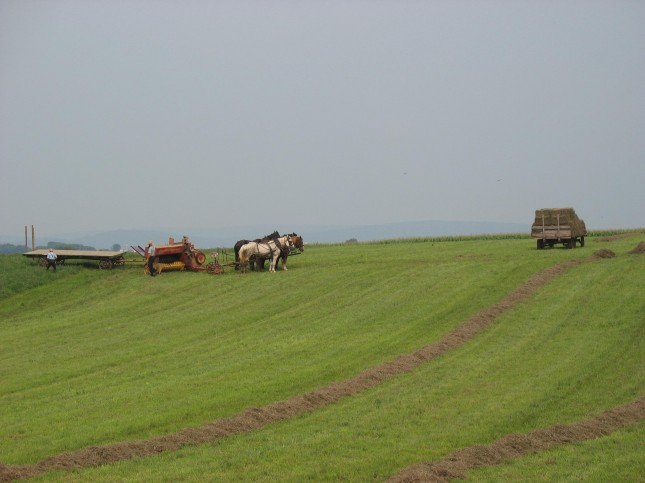The Riddle of Amish Culture by Donald B. Kraybill, The John Hopkins University Press, Maryland, 2001(rev. edn.) is an outstanding examination of the Amish people.
The ‘riddles’ of Amish culture are many and varied to the outsider. Professor Kraybill, an acknowledged authority on the Amish, takes the reader on a fascinating journey of discovery of these people. The book focuses on the culture of traditional or ‘Old Order’ Amish in Lancaster County, Pennsylvania, although other Amish and Mennonite groups are noted.
‘Riddles’ include: Why do the Amish use horses to pull modern farm machinery? Why can a car be used but not owned? Why can a telephone be installed in a shanty in the barn or yard but not in the house? Why the uniformity of beards, bonnets and buggies in the 21st century? Why can young Amish be allowed to ‘sow their wild oats’ during ‘rumspringa’ but not be permitted to attend local schools?
‘The big riddle, however, eclipses all the smaller ones: How is it that a tradition-laden people who spurn, electricity, computers, automobiles, and higher education are not merely surviving but are, in fact, thriving in the midst of modern life?’
The answer to these riddles lie in the social and cultural capital of the Amish. These are the resources needed for the Amish to engage creatively and productively as they negotiate with the forces of the modern world. Cultural capital is seen in Christian values: yieldedness, self-denial, obedience, trust and mutual aid. Social capital includes the social rituals, networks, extended family, locally based life and organizational structures.
The ability of the Amish to negotiate with the forces of the modern world in seeking to preserve their community is well illustrated in the book by stories and quotes.
Consider the car. Negatively, a car gives freedom to individuals, independence from the community, disrupts the slow pace of Amish life, mocks humility and equality and enables interaction with the modern world. Positively, the car helps in emergencies and with visiting distant family. The resolution: the Amish can use but not own a car.
Consider the telephone. A telephone is permitted if it is located away from the house so as to avoid it interrupting family life and work. Stopping incoming calls to the home gives control of the phone to the family regarding the people who can enter into conversation with family members and denies access from the world of violence, egotism and consumerism. On the other hand, the telephone can be very helpful in emergencies, for business and with family living further away in newly established Amish settlements. So a ‘telephone shanty’ that is away from the house is permitted. See photo below.
I found Chapter 2 which explores the cultural underpinnings of Amish life, of particular value. The Old Order Amish emphasis on ‘tradition before all else’ is based on Gelassenheit: the yielding of self to the family, church and God. As mentioned in earlier articles this underpins a process of socialization from cradle to grave in a cultivated social life of church, family, home, school, work and recreation.
A suggestion: This chapter lends itself to a reading group for discussion.
The book’s concluding chapter, Exploring our Common Riddles, presents this challenge:
Is it possible to forge a culture – a social habitat – where the individual and the community are not pitted against each other as adversaries, but where they supplement, complement, and enrich each other? That is the common riddle that begs all of us – Amish and Moderns alike – for a solution.
I highly commend this easily read, clearly structured and well illustrated book that answers many of the ‘riddles’ of the Amish and advances a challenge to ourselves.
Of related interest is Amish Studies, an academic website developed by the Young Center for Anabaptist and Pietist Studies at Elizabethtown College (Pa.) to provide reliable information on Amish life and culture. The principal investigator, Professor Donald B. Kraybill, is the author of the above reviewed book.
 The ‘Riddle’ of Amish Culture is symbolized on the book’s cover by two young Amish women in traditional dress of bonnet and plain clothes and yet skating on modern roller blades. The Riddle: how are tradition and modernity held together by the Amish?
The ‘Riddle’ of Amish Culture is symbolized on the book’s cover by two young Amish women in traditional dress of bonnet and plain clothes and yet skating on modern roller blades. The Riddle: how are tradition and modernity held together by the Amish?
 A ‘telephone shanty’ is located away from the house.
A ‘telephone shanty’ is located away from the house.
 Horse drawn machinery – why persist with horses?
Horse drawn machinery – why persist with horses?
 No quilt sales on Sunday: how can the Amish be in the world but not of it?
No quilt sales on Sunday: how can the Amish be in the world but not of it?

